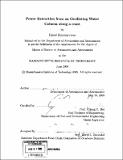| dc.contributor.advisor | Chiang C. Mei. | en_US |
| dc.contributor.author | Martins-rivas, Hervé | en_US |
| dc.contributor.other | Massachusetts Institute of Technology. Dept. of Aeronautics and Astronautics. | en_US |
| dc.date.accessioned | 2009-04-29T17:15:59Z | |
| dc.date.available | 2009-04-29T17:15:59Z | |
| dc.date.copyright | 2008 | en_US |
| dc.date.issued | 2008 | en_US |
| dc.identifier.uri | http://hdl.handle.net/1721.1/45257 | |
| dc.description | Thesis (S.M.)--Massachusetts Institute of Technology, Dept. of Aeronautics and Astronautics, 2008. | en_US |
| dc.description | Includes bibliographical references (p. 121-123). | en_US |
| dc.description.abstract | For reasons of wave climate, geography, construction, maintenance, energy storage and transmission, some devices for extracting energy from sea waves will likely be installed on the coast. We study here the specific case where an Oscillating Water Column (OWC) is attached to the tip of a long breakwater. A three-dimensional numerical model of a skeletal geometry of the the Foz do Douro breakwater is developed in order to determine the response inside the OWC pneumatic chamber to incident waves and assess the possible effects of the breakwater geometry. The model uses the hybrid element method and linear water wave theory. Then, a more analytical approach for a simplified geometry is presented. Making use of an exact solution for the scattering by a solid cylinder connected to a wedge, we solve for the linearized problems of radiation and scattering for a hollow cylinder with an open bottom. Power-takeoff by Wells turbines above an air chamber is modeled by including the compressibility of air. It is shown for the case of a circular OWC attached to a thin breakwater, that the incidence angle affects only the waves in and outside the column but not the power extraction which depends only on the averaged water-surface displacement inside. Optimization by controlling the turbine characteristics is examined for a wide range of wavelengths. Finally, the same approach is used to solve the case of an OWC positioned along a straight coast line. It is found that in this configuration, the extracted power does depend on the incidence angle. It is also shown that the average efficiency is doubled compared to the thin breakwater geometry. | en_US |
| dc.description.statementofresponsibility | by Hervé Martins-rivas. | en_US |
| dc.format.extent | 123 p. | en_US |
| dc.language.iso | eng | en_US |
| dc.publisher | Massachusetts Institute of Technology | en_US |
| dc.rights | M.I.T. theses are protected by
copyright. They may be viewed from this source for any purpose, but
reproduction or distribution in any format is prohibited without written
permission. See provided URL for inquiries about permission. | en_US |
| dc.rights.uri | http://dspace.mit.edu/handle/1721.1/7582 | en_US |
| dc.subject | Aeronautics and Astronautics. | en_US |
| dc.title | Power extraction from an oscillating water column along a coast | en_US |
| dc.type | Thesis | en_US |
| dc.description.degree | S.M. | en_US |
| dc.contributor.department | Massachusetts Institute of Technology. Department of Aeronautics and Astronautics | |
| dc.identifier.oclc | 310365510 | en_US |
